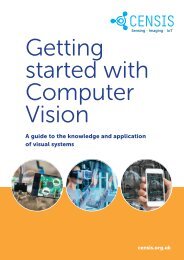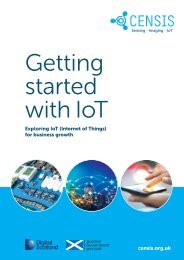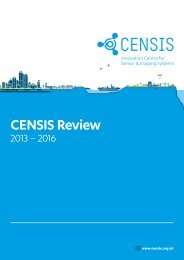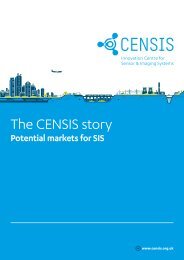CENSIS white paper: Intellectual Property in Business
2023: This CENSIS white paper sets out to make the topic of IP more approachable, less intimidating and more manageable, offering experience-based advice and methods are are designed to help businesses structure their IP- related issues and makes the best of their IP. Covering: The role of IP, IP management during growth, IP strategy for expanding companies and corporates, Business IP Canvas - merging IP with your business model.
2023: This CENSIS white paper sets out to make the topic of IP more approachable, less intimidating and more manageable, offering experience-based advice and methods are are designed to help businesses structure their IP- related issues and makes the best of their IP.
Covering:
The role of IP, IP management during growth, IP strategy for expanding companies and corporates, Business IP Canvas - merging IP with your business model.
Create successful ePaper yourself
Turn your PDF publications into a flip-book with our unique Google optimized e-Paper software.
<strong>Intellectual</strong> <strong>Property</strong> <strong>in</strong> Bus<strong>in</strong>ess: IP basics, IP management, IP strategy<br />
IP Management dur<strong>in</strong>g Growth (cont<strong>in</strong>ued)<br />
9 Identify IP opportunities for<br />
your company – the sources<br />
of <strong>in</strong>formation<br />
The more you know about the market and competitors, the<br />
better it is for your bus<strong>in</strong>ess decisions. In order to identify IP<br />
opportunities, you need to add an IP perspective <strong>in</strong>to many<br />
analyses you have been do<strong>in</strong>g already, such as technology<br />
trend analyses or market analyses (for example, on bus<strong>in</strong>ess<br />
models adopted by your competitors). However, some<br />
strictly IP-based searches can deliver significant amounts of<br />
valuable bus<strong>in</strong>ess <strong>in</strong>formation.<br />
Prior art search (also known as state-of-the-art search<br />
of patent and non-patent literature) can be a very useful<br />
practice <strong>in</strong> your company <strong>in</strong> order to comprehend the<br />
level of development <strong>in</strong> a particular technical field and<br />
to guide your R&D efforts. You need to be cognisant of<br />
the risks <strong>in</strong>volved <strong>in</strong> uncover<strong>in</strong>g potential <strong>in</strong>fr<strong>in</strong>gements,<br />
especially if you are trad<strong>in</strong>g <strong>in</strong> the USA and Ch<strong>in</strong>a where<br />
patent damages can be <strong>in</strong>creased for ‘wilful <strong>in</strong>fr<strong>in</strong>gement’.<br />
However, these risks are balanced aga<strong>in</strong>st the benefits that<br />
come from know<strong>in</strong>g the state of the art. (You should get<br />
legal advice on these issues to help you balance the risks.)<br />
The prior art search should be <strong>in</strong>cluded <strong>in</strong> the <strong>in</strong>itial<br />
phase of your <strong>in</strong>novation process, i.e. when you start<br />
th<strong>in</strong>k<strong>in</strong>g about a solution to a particular problem (before<br />
you even <strong>in</strong>vent anyth<strong>in</strong>g). You should look for so-called<br />
‘<strong>white</strong> spots’ 23 which refer to areas of miss<strong>in</strong>g knowledge;<br />
these <strong>in</strong> turn can lead you to opportunity areas for<br />
<strong>in</strong>novation and untapped potential. Through the prior art<br />
search, you can also ga<strong>in</strong> good <strong>in</strong>sights <strong>in</strong>to the patent<br />
activities of your potential competitors. Another moment<br />
for an <strong>in</strong>tensive patent search is dur<strong>in</strong>g the preparation of<br />
a patent application. A patent attorney will run the search<br />
for the patentability of the proposed solution.<br />
The choice of search terms (comb<strong>in</strong>ations, synonyms,<br />
descriptions) is decisive for gett<strong>in</strong>g good results from a<br />
patent search. Thus, some level of l<strong>in</strong>guistic creativity<br />
is advisable when do<strong>in</strong>g this. Another search path goes<br />
through patent classifications such as International Patent<br />
Classification or Cooperative Patent Classification. This<br />
search relies on codes provided by a patent exam<strong>in</strong>er for<br />
patented or published solutions based on their technical<br />
characteristics. The codes identify a technology field and<br />
can help you monitor technology trends <strong>in</strong> a specific field.<br />
You should also monitor and understand the IP practices<br />
of your competitors, and your patent attorney can also<br />
track the IP activities of chosen competitors/companies.<br />
There are software tools designed for this task. If their<br />
patents have been published, read them. Try to understand<br />
what they claim (which features), which applications they<br />
are <strong>in</strong>terested <strong>in</strong>, and <strong>in</strong> which countries they are seek<strong>in</strong>g<br />
patent protection. The latter will give you a h<strong>in</strong>t about their<br />
target markets (territories). Written communication with<br />
patent offices is public and can be easily accessed through<br />
patent office databases (e.g., Espacenet from the European<br />
Patent Office). Such official correspondence is a great<br />
source of <strong>in</strong>formation: you can see how each patent atta<strong>in</strong>s<br />
its ‘f<strong>in</strong>al shape’, you can f<strong>in</strong>d out exam<strong>in</strong>ers’ comments<br />
and objections, read replies from patent attorneys, and<br />
check if the patent is alive or lapsed and its priority date. If a<br />
particular patent application is of concern for your bus<strong>in</strong>ess,<br />
it is worth div<strong>in</strong>g <strong>in</strong>to the procedural aspects and consult<strong>in</strong>g<br />
your patent attorney on possible steps. Be aware that your<br />
competitors may be do<strong>in</strong>g the same!<br />
In addition, analys<strong>in</strong>g your competitors may reveal an<br />
opportunity for cross-licens<strong>in</strong>g (or patent pool<strong>in</strong>g) or<br />
one-way licens<strong>in</strong>g. For example, if there is any overlap<br />
between your solution and your competitor’s solution that<br />
could <strong>in</strong>crease the risk of <strong>in</strong>fr<strong>in</strong>gement and litigation, then<br />
a cross-licence might a reasonable option for both parties.<br />
Likewise, if your and your competitor’s IP portfolio cover<br />
different aspects of the same product, a cross-licence (or<br />
a patent pool <strong>in</strong> case of very complex technologies) might<br />
save you time and money that could otherwise be <strong>in</strong>vested<br />
<strong>in</strong> further development (a workaround solution). A crosslicence<br />
might be royalty-based but also royalty-free.<br />
This depends on the circumstances and negotiation<br />
positions of the parties <strong>in</strong>volved.<br />
Another source of <strong>in</strong>formation is primary sources, such as<br />
direct <strong>in</strong>terviews with your customers, for example, on their<br />
acceptance level of ‘closed’ IP practices. It may be the case<br />
that the targeted customer group is reluctant to purchase<br />
the products of companies practis<strong>in</strong>g ‘closed’ IP models.<br />
This <strong>in</strong>formation should not prevent you from develop<strong>in</strong>g<br />
an IP portfolio but should be utilised when fram<strong>in</strong>g the<br />
bus<strong>in</strong>ess model (pric<strong>in</strong>g and revenue streams).<br />
Take-home message: IP-based searches, <strong>in</strong> particular<br />
patent searches, can deliver priceless <strong>in</strong>put for your<br />
bus<strong>in</strong>ess decisions. Consult your IP attorney on the types<br />
and scope of patent searches, and they can advise what<br />
will work best for you.<br />
23<br />
The term is also used <strong>in</strong> patent jargon; a <strong>white</strong> spot analysis describes a special type of patent mapp<strong>in</strong>g.<br />
23

















